Earlier this year, I received an email saying that the Auckland branch of the GeoClub had organised a trip down into the depths of the Earth. Specifically, into one of the longest lava tubes underneath Auckland, Wiri Lava Cave. Not many people get to go down there, and they had secured permits and an iwi blessing to enter the cave–it is locked with a metal grate at the entrance and, until very recently, no one had gotten permission to enter it since 1998!
The GeoClub folks (led by Bruce Hayward, Godfather of all things Auckland Volcanic Field) also arranged for NZ’s foremost cave expert, Peter Crossley, to guide us around. These opportunities for adventure are just one of the perks of the job. I’m happy to get to share them here!
Just as an aside, there are lava tubes all over Auckland. Check out how they form:
I excitedly gathered a group of keen volcanologists from Auckland Uni to go. But first, of course, we had to learn some specifics about what we were seeing. Bruce explained how the cave entrance and lava tube we were about to travel through was once covered by a large scoria cone. The cave is still surrounded by scoria. Unfortunately pictures of the original cone do not exist; by the time they took any pictures of it in the 1940’s, parts of it had already been quarried away. The quarry is still there (not pictured).

Bruce (centre) gestures to help us visualize the large scoria cone that used to be where we are standing, prior to quarrying. Then…we ENTER!
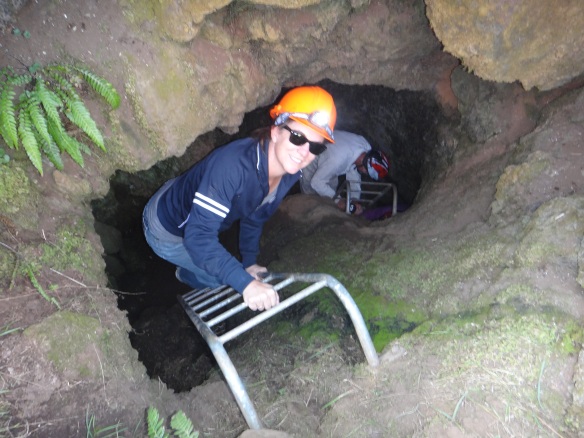
Some modification of the cave entrance meant that we had ladders to climb down into the tube. Here, my boss (Jan Lindsay) demonstrates that she is so cool, she even wears shades when climbing into caves.
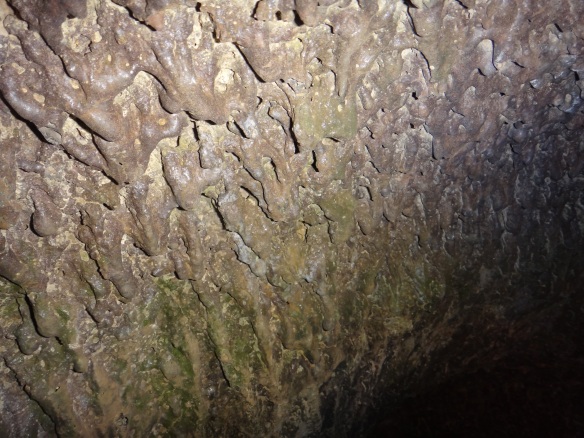
My turn to enter the tube! These are lava drip structures just on the inside of the entrance. They formed when the roof and walls of the lava tube remelted from the heat of the flowing lava. (Sorry no scale–each is about a pinky finger width or less.)
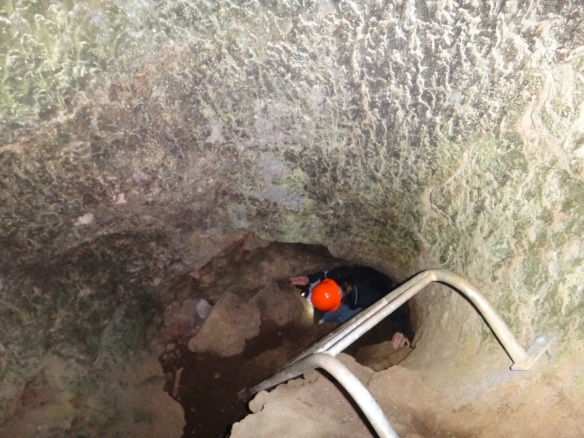
One ladder down, one more to go. After that there is a little bit of a scramble a few meters down even further.
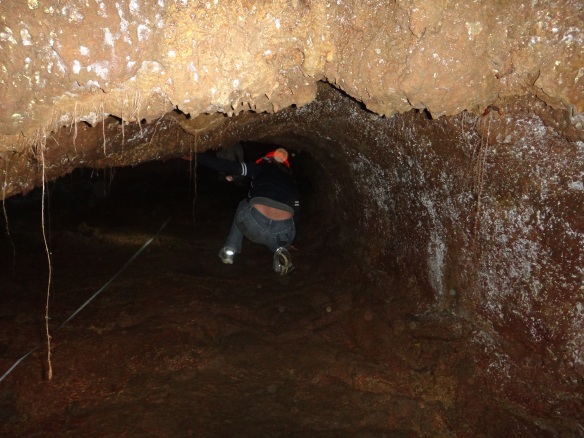
After which there is a little bit of a duck-crawl for about 10-15 meters before getting to a larger tube where you can stand up.
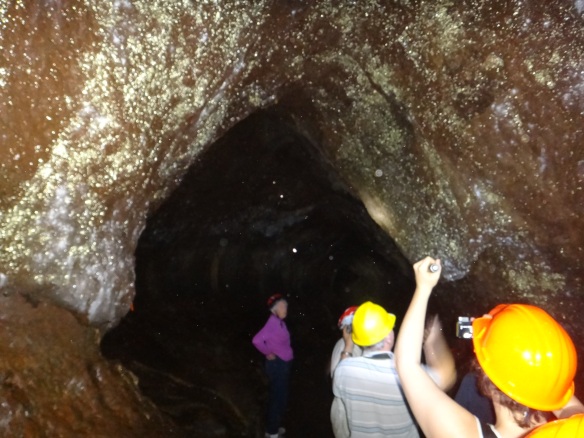
After crawling for a bit, it is a relief to enter a large cave tall enough to stand in. Notice the pointy roof–Bruce thinks it is not rounded (as expected) because while the roof was still plastic, flexible, and hot, the weight of the overlying scoria pushed it inward. Sounds right to me! Still no consensus on what that shiny yellow biogenic stuff on the walls is. We need a biologist, STAT!
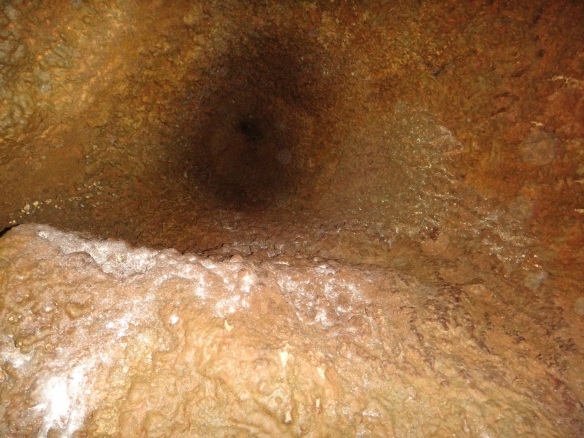
This was taken looking straight up. The gases and lava tried to push its way through the lava tube roof and scoria to the surface. It didn’t quite make it. This is how horitos form (http://volcanoes.usgs.gov/images/pglossary/hornito.php).

The walls of the cave are just a thin (maybe a few cm thick?), melted coating of lava, surrounded by pieces of scoria.
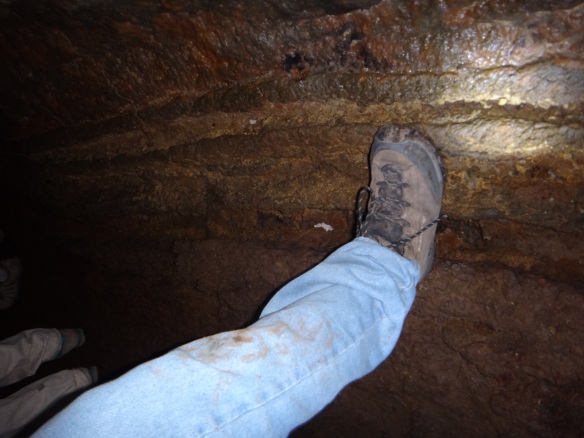
Ropy textures on the cave floor mark the edges of the channels where the lava flowed, and allow you to see ‘high-tide’ marks of where the lava level rose and then drained away on the bottom half of the walls, and the ‘runway’ of the last dregs of magma on the floor. Such amazing textures!!
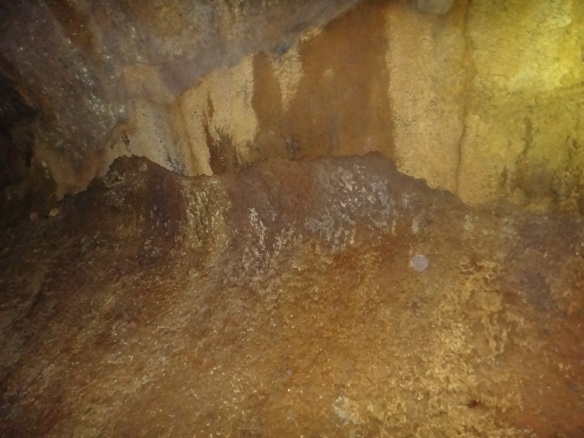
‘High tide’ marks of the last few lava flows to come through the tube. Or it could be where some of the thin lava cave walls broke off. It also allows you to see how thin the lava coating is.
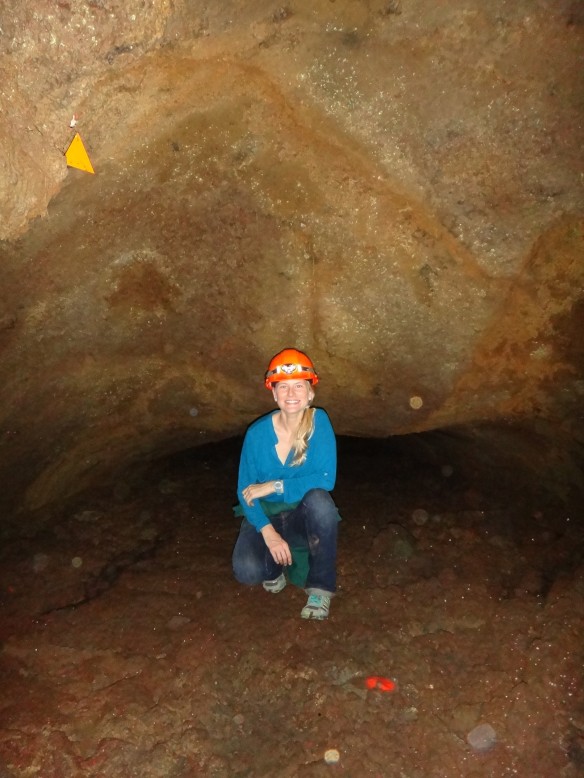
Here I am just before ‘The Squeeze’ and right before my claustrophobia kicks in. It gets quite narrow here. Again, you can see a survey marker above my head.
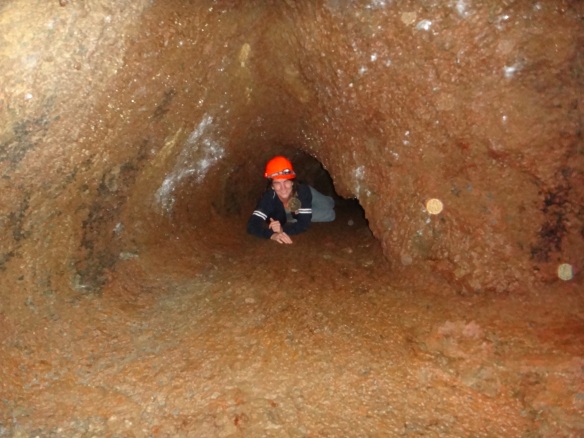
Upon turning around and heading back to the surface, Jan took an alternate route through a small channel in the lava tube.
There are a lot of lava tubes in Auckland that are publicly accessible, though not as extensive as this one. Rangitoto, for example, has a few if you are brave and prepared enough to explore them while you are over there!
It was a really great day exploring this hidden geological wonder right here in our backyard. I just want to thank the Auckland GeoClub once again for arranging this truly exciting, one-of-a-kind outing. Happy lava-tube exploring!

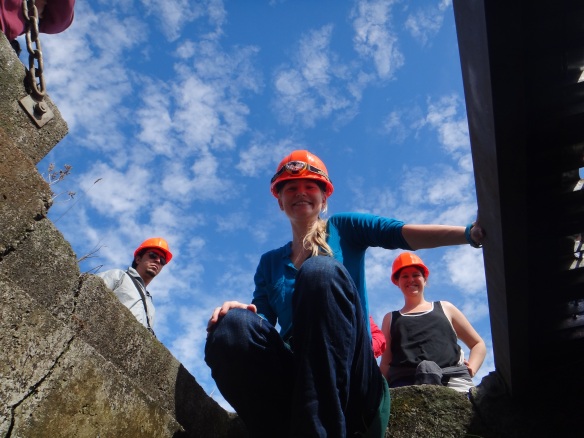
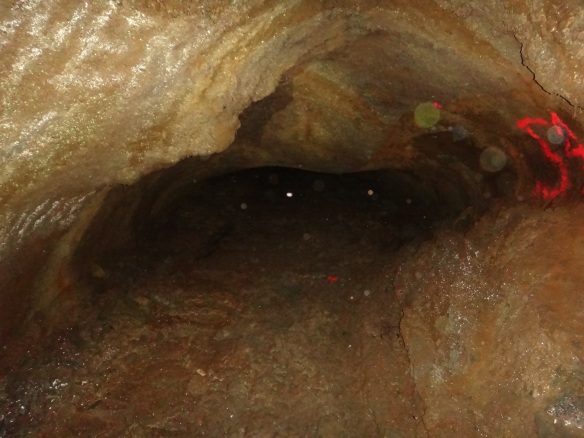

Glad to see the cave is in good condition . I spent over 6 years campaigning to have this cave saved and have spent many-many hours in the cave both clearing rocks and debris which farmers had thrown down over the years to taking numerous important people such as the now ‘Sir Barry Curtis , and lots of officials from the then ARA , Manukau City Council and others government departments down the cave to try and get support in getting the cave saved . I was on National television a number of times to create public awareness as the cave was under threat from the NZ railways quarry and then Fillaul and Barry Ltd who took over the quarry . the many hours I spent trying to save the cave came close to costing me my job and my marriage , that’s how important it was and still is to me . 1989 saw us move from Manurewa as the area ‘took a dive ‘ and I am now back in Auckland and am very keen to get a look back down the old girl . My dear friend and geologist who gave me great support through all this has sadly passed on and is sadly missed . My kindest regards
Rob Martinson .
Hi Rob,
Thank you so much for your comment. I’m very grateful for the time you dedicated to saving and maintaining this special feature of the Auckland Volcanic Field! THANK YOU! It is spectacular–so many unique features! Other than the surveyor’s unfortunate spray-painted marks, it was pristine.
We were very excited about our field trip through the lava tube–so very honored to be one of the few to explore it. We were able to get access through the Auckland branch of the NZ Geoclub–doubtful that you aren’t familiar with him already, but B. Hayward is the person to chat to to get info about access. I’m sure he’d also like to chat to you about your efforts as he is very active in preserving natural heritage features.
Who was your geologist friend?
All the best,
Elaine
I would be very interested to know when you next plan on going into the cave… Amateur rock enthusiast
Great news — the lava tubes on Rangitoto are always open and free to the public!
I don’t have access to any of the other Auckland lava tubes, however — we were invited specially from others for the Wiri lava tube years ago, never before and never since, sadly.
I’ve been tho one lava tube on rangitoto the other one I didn’t cause I didn’t think I could climb out
fair enough! Yep, best to be careful in the field 🙂
I left a comment at the other end of this comment-pile.
I still think it a huge pity that ‘experts’ and officials have taken the cave and control access …
How does a member of the public get an invite and permit to enter the cave. I have wanted to go for years
Hi Russell! I have no idea, I was very lucky to get an invite through the Auckland GeoClub. Perhaps chat with them in case there is another opportunity? http://www.gsnz.org.nz/information/auckland-branch-i-46.html
How I wish I could be in a lave tube
I explored this cave in the very early sixties. There will still be little piles of candle wax in strategic places, we left candles burning behind us when we came out for the final time.
In those days we had to wriggle down through a constricted entrance (now gone, “improved”).
You want real silence? And to hear the planet’s ‘hum’? You’ve missed your chance by decades, I would think that even electric lights will be audible in there.
Pingback: #5. Matukutūruru (Wiri Mountain) – KiwiUnschool